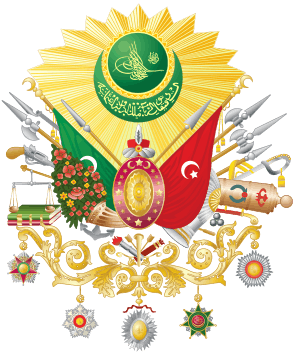Mihrengiz Kadın
Mihrengiz Kadın (Ottoman Turkish: مهرانکیز قادین; 15 October 1869 - 12 December 1938) was the second wife of Sultan Mehmed V of the Ottoman Empire.[1]
| Mihrengiz Kadın | |||||
|---|---|---|---|---|---|
| Born | Fatma 15 October 1869 Sochi, North Caucasus | ||||
| Died | 12 December 1938 (aged 69) Alexandria, Egypt | ||||
| Burial | |||||
| Spouse | Mehmed V | ||||
| Issue | Şehzade Ömer Hilmi | ||||
| |||||
| House | Ottoman (by marriage) | ||||
| Religion | Sunni Islam | ||||
Early life
Mihrengiz Kadın was born on 15 October 1869 in Sochi, North Caucasus [2]. Born as Fatma, she belonged to the Ubykh clan of Circassians.[3] She had a brother named Ibrahim Bey.[4]
In 1864, during the ethnic cleansing of Circassians, she had been brought to Istanbul as a young child, where her father entrusted to the imperial harem. Her name according to the custom of the Ottoman court was changed to Mihrengiz.[5]
Marriage
Mihrengiz married Mehmed as his second wife, when he had been a prince. On 2 March 1888, she gave birth to her only son, Şehzade Ömer Hilmi in the Veliahd Palace.[6] On 27 April 1909, after Mehmed's accession to the throne,[7] she was given the title of "Second Consort".[1]
In 1912, the "Hilal-i Ahmer Centre for Women" was organized within the "Ottoman Hilal-i Ahmer Association", a foundation established in 1877 to provide medical care in Istanbul and surrounding communities.[8] Mihrengiz was a member of this organization.[4]
Safiye Ünüvar, a teacher at the Palace School, whom she met in 1915, noted in her memoirs that unlike the other wives, Mihrengiz was slim, while the others were quite heavier. This was because she had been suffering from illness from the past few years.[9][10]
On 30 May 1918, Mihrengiz met with the Empress Zita of Bourbon-Parma in the harem of Yıldız Palace, when the latter visited Istanbul with her husband Emperor Charles I of Austria.[11]
Last years and death
In 1924 they went into exile and settled in Alexandria. Her son suffered from a stroke and died soon after settling in Alexandria. She died on 12 December 1938 at Alexandria and was buried in the Mausoleum of the Egyptian prince Omar Tusun Pasha.[1]
Issue
Mihrengiz and Mehmed had one son:
- Şehzade Ömer Hilmi (Veliahd Palace, Istanbul, 2 March 1886 – Alexandria, Egypt, 6 April 1935, buried in Ömer Tosun Pasha Mausoleum);
References
- Uluçay 2011, p. 260.
- Brookes 2010, p. 284.
- Açba 2007, p. 168.
- Açba 2007, p. 170.
- Açba 2007, p. 169.
- Brookes 2010, p. 287.
- Faroqhi, Suraiya (2008). The Cambridge History of Turkey. Cambridge University Press. p. 79. ISBN 978-0-521-62096-3.
- Hacker, Barton; Vining, Margaret (August 17, 2012). A Companion to Women's Military History. BRILL. p. 199. ISBN 978-9-004-21217-6.
- Brookes 2010, p. 208.
- Sakaoğlu 2008, p. 702.
- Açba, Leyla (2004). Bir Çerkes prensesinin harem hatıraları. L & M. p. 56. ISBN 978-9-756-49131-7.
Sources
- Uluçay, M. Çağatay (2011). Padişahların kadınları ve kızları. Ötüken. ISBN 978-9-754-37840-5.
- Açba, Harun (2007). Kadın efendiler: 1839-1924. Profil. ISBN 978-9-759-96109-1.
- Sakaoğlu, Necdet (2008). Bu Mülkün Kadın Sultanları: Vâlide Sultanlar, Hâtunlar, Hasekiler, Kandınefendiler, Sultanefendiler. Oğlak Yayıncılık. ISBN 978-6-051-71079-2.
- The Concubine, the Princess, and the Teacher: Voices from the Ottoman Harem. University of Texas Press. 2010. ISBN 978-0-292-78335-5.
